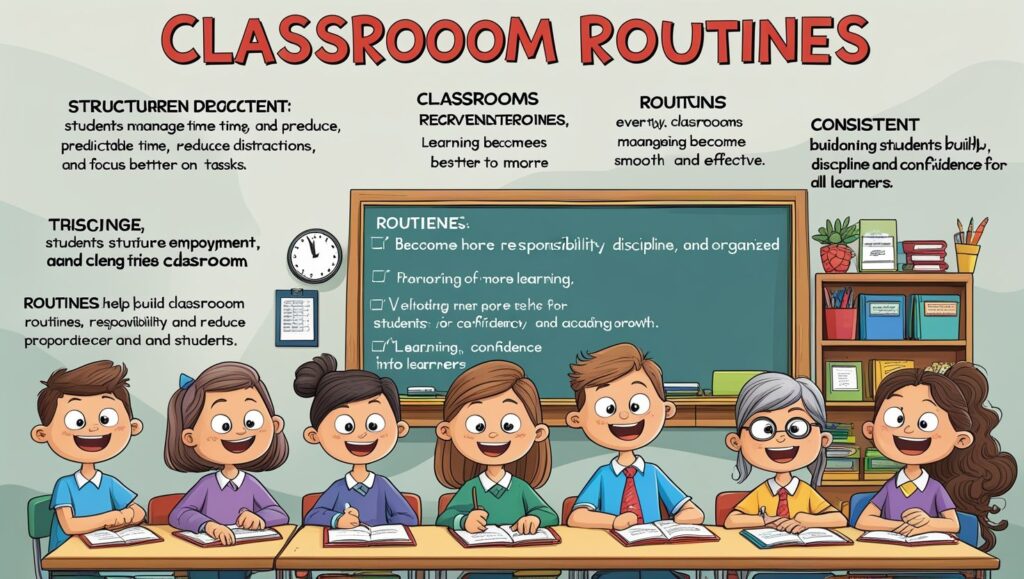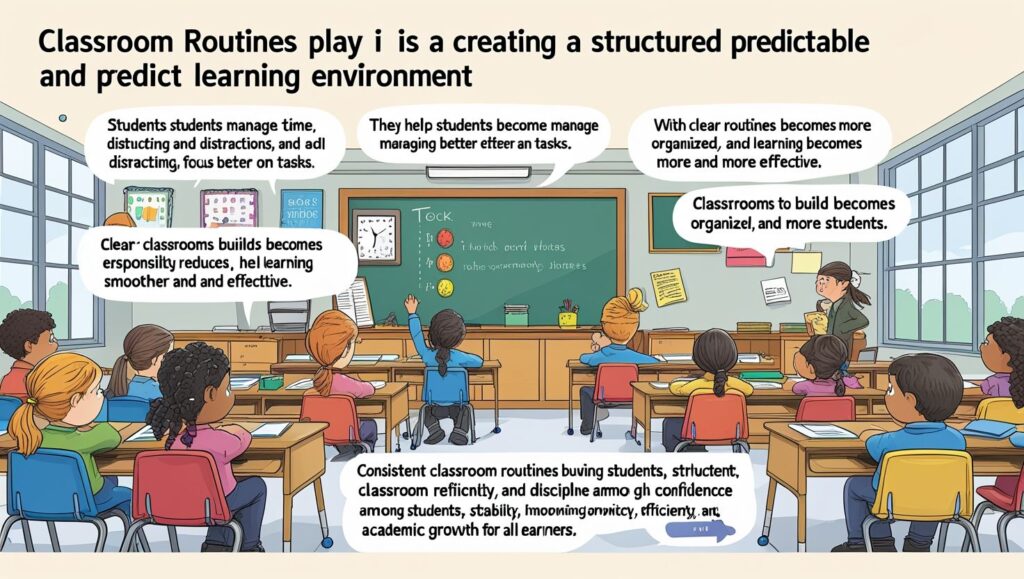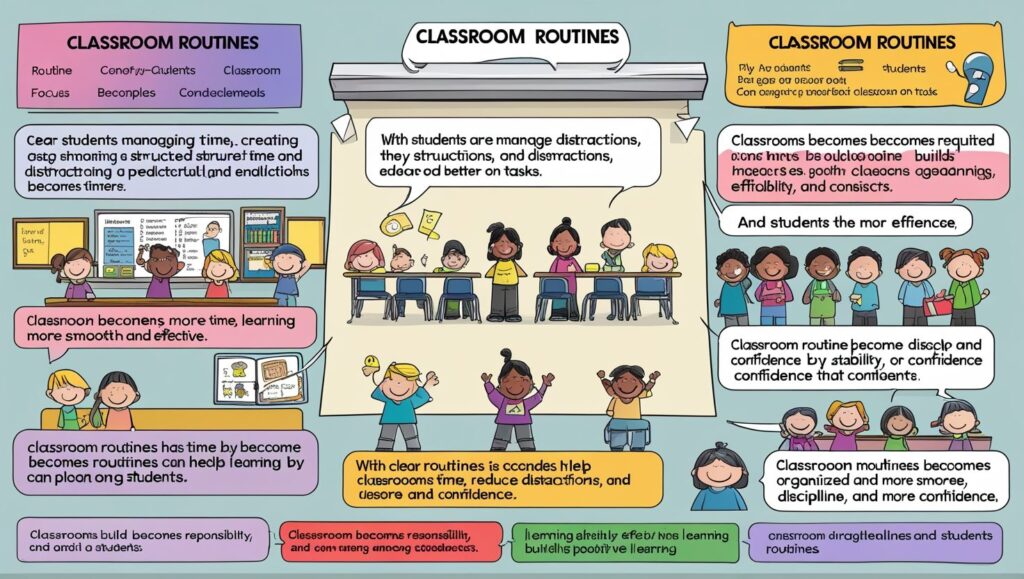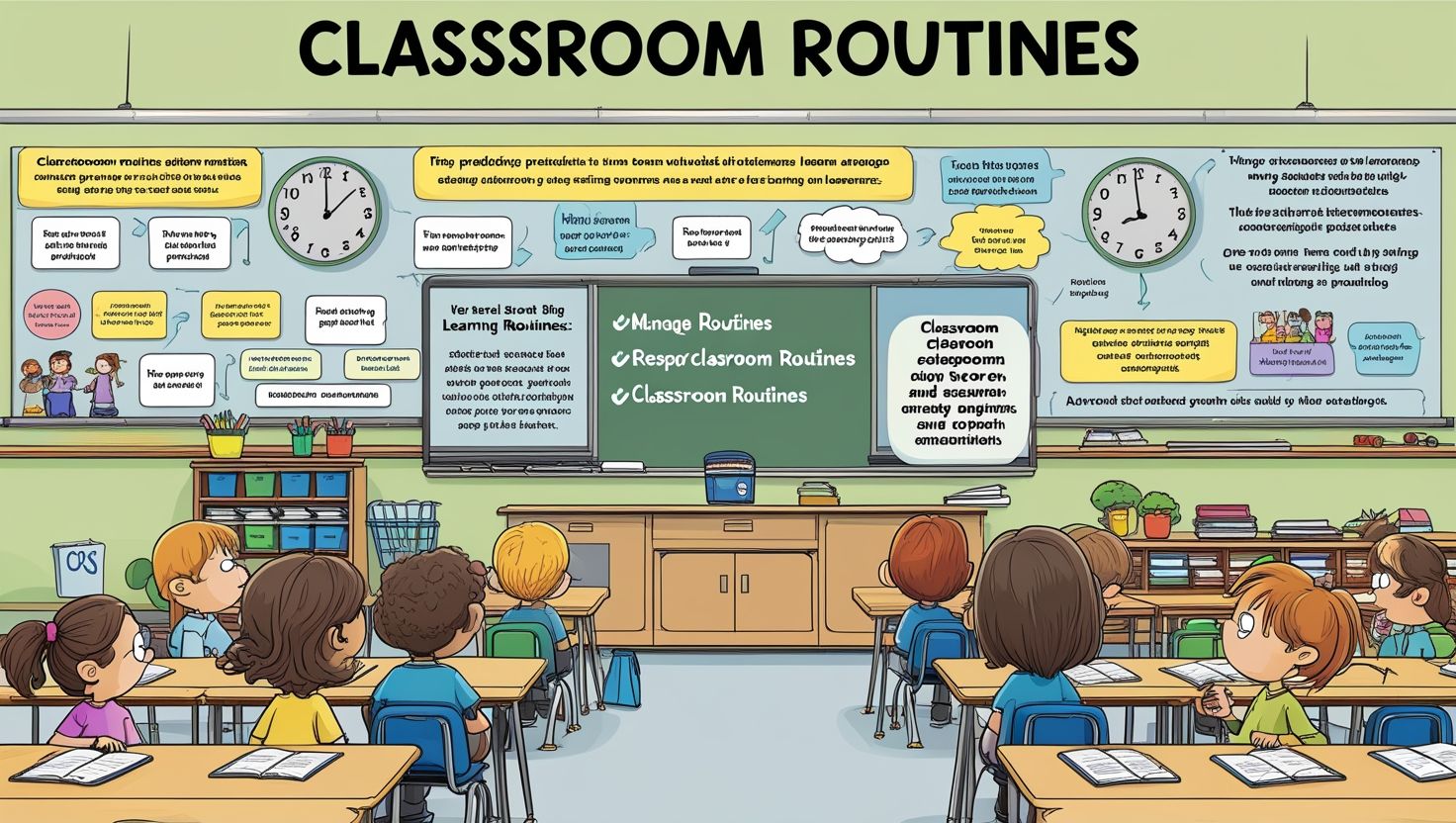Introduction
Impact of Classroom Routines on Learning, Classroom routines form the backbone of effective teaching and learning. They provide structure, order, and predictability. When routines are consistently applied, students feel safe and focused. Teachers also manage time better and reduce disruptions. Additionally, routines create a sense of community and shared responsibility. Learning becomes smoother, and progress is measurable. Without routines, classrooms often become chaotic and stressful. Students may struggle to stay on task, and teachers may lose valuable instructional minutes. Therefore, establishing routines is not just an organizational tool but a teaching strategy. Furthermore, routines help students build habits of responsibility and self-control. These habits are vital for academic success and personal growth. Teachers who use routines wisely promote positive classroom environments. As a result, students engage more deeply and retain knowledge effectively. In conclusion, classroom routines are not merely about order; they are about fostering learning, respect, and productivity. This essay explores their impact, importance, challenges, and benefits in detail.
Establishing a Learning-Friendly Environment
A learning-friendly environment depends on strong routines. With predictable patterns, students understand what to expect. They also learn how to behave. This clarity reduces confusion and anxiety. Moreover, routines create stability, which is essential for young learners. When students know when to start, what to bring, or how to respond, they save time and energy. Teachers, too, benefit by avoiding repetitive instructions. Instead, they focus on meaningful teaching tasks. Classroom order also enhances peer relationships. Students collaborate better when they follow shared rules. In addition, a structured environment minimizes conflicts. Learners spend less time adjusting and more time engaging. Furthermore, parents observe the benefits at home, as children extend learned discipline into daily life. Teachers who consistently practice routines send a message of reliability and fairness. Over time, students begin to take responsibility for their learning. They prepare independently and develop self-discipline. Hence, routines lay the foundation for a productive and supportive learning culture. This environment nurtures creativity, curiosity, and respect. Overall, classroom routines create fertile ground where knowledge can truly flourish.
Enhancing Student Engagement
Student engagement rises significantly with structured routines. Engagement thrives when learners feel comfortable and guided. With routines, transitions become smoother, and interruptions decline. This allows students to stay focused. Moreover, routines give students a clear roadmap. They know what comes next and prepare accordingly. This anticipation reduces hesitation and increases participation. Teachers, on the other hand, waste less time giving directions. Consequently, students enjoy more time for interaction and exploration. Furthermore, routines often include group work, discussions, or reflection periods. These planned practices sustain interest and active involvement. Over time, students recognize the value of participation. They develop confidence and enthusiasm. In addition, consistent routines reduce distractions caused by uncertainty. Students no longer worry about unexpected changes. They invest their energy in learning tasks instead. Additionally, clear routines accommodate different learning styles. Visual, auditory, or kinesthetic learners all benefit from repeated patterns. Engagement also improves when students feel respected and secure. Routines provide that assurance. As a result, learners become more responsible for their roles. Ultimately, engagement builds deeper comprehension and long-term achievement.

Promoting Discipline and Responsibility
Classroom routines play a vital role in discipline. Rules alone cannot ensure good behavior. However, routines reinforce discipline naturally. They teach students the value of consistency and self-control. For example, lining up quietly before class becomes a habit. Over time, such practices develop into lifelong skills. Furthermore, routines encourage responsibility. Students learn to bring materials, complete tasks, and respect deadlines. Teachers do not need to remind them repeatedly. Instead, routines guide their behavior automatically. This shift reduces teacher stress and empowers students. Additionally, routines promote fairness. Every learner follows the same procedure, eliminating confusion or bias. In turn, discipline becomes shared responsibility. Moreover, routines build trust between students and teachers. Predictability makes students feel respected and valued. They respond by following rules more willingly. Discipline, then, is not forced but nurtured. Responsibility grows hand in hand with independence. Students learn to take charge of their learning journey. Over time, disciplined behavior extends beyond classrooms into real life. Hence, routines not only improve classroom order but also prepare students for society.
Improving Academic Performance
Academic performance improves with strong routines. Predictable classroom patterns maximize learning time. Students do not waste energy wondering what to do next. Instead, they focus on tasks. This consistency enhances concentration. Furthermore, routines encourage regular study habits. Learners review, practice, and revise more effectively. Repeated patterns strengthen memory and comprehension. Moreover, routines help teachers deliver lessons systematically. They align activities with objectives and ensure progress. As a result, lessons are not rushed or incomplete. Students grasp concepts more clearly. Additionally, routines support collaborative learning. Group discussions or peer reviews become effective when planned regularly. These interactions enrich understanding and boost confidence. In the long run, routines create academic stability. Learners face fewer disruptions and achieve steady improvement. Furthermore, routines allow for targeted interventions. Teachers can identify struggling students quickly. Consistent schedules make it easier to measure growth. Ultimately, routines promote discipline, which directly impacts grades. They also reduce exam anxiety, as students are accustomed to structured preparation. Thus, routines serve as invisible guides that lead learners to higher academic success.
Supporting Emotional Well-Being
Emotional well-being is closely linked with classroom routines. Predictable patterns create a safe and stable atmosphere. Students feel secure when they know what comes next. This reduces anxiety and stress. Moreover, routines help students develop a sense of belonging. Shared practices connect learners to their peers. They also strengthen relationships with teachers. In turn, this emotional security supports learning. Additionally, routines reduce uncertainty, which often causes behavioral issues. When learners feel guided, they stay calm and focused. Teachers also benefit emotionally, as classroom management becomes less stressful. Furthermore, routines provide time for relaxation and creativity. Scheduled breaks, reflections, or group activities reduce pressure. These moments help students reset and recharge. Over time, routines nurture resilience and confidence. Learners know how to manage challenges within structured boundaries. Moreover, emotional stability enhances motivation. Students participate more willingly and show greater enthusiasm. Positive emotions then reinforce learning outcomes. Thus, routines serve not only academic but also psychological needs. They balance order with care, ensuring that education develops both the mind and the heart.

Building Teacher Effectiveness
Teacher effectiveness increases through the use of routines. With structured patterns, teachers save valuable time. They spend less energy repeating instructions or managing disruptions. This efficiency allows for more quality teaching. Furthermore, routines empower teachers to focus on creativity. They plan engaging lessons instead of worrying about order. Additionally, routines reduce stress. Predictable schedules make teaching smoother and more rewarding. Over time, teachers build confidence in their classroom management skills. Moreover, routines promote fairness. All students receive equal expectations and treatment. This transparency strengthens teacher credibility. Furthermore, routines allow teachers to identify patterns of learning. They observe who struggles or excels. This data helps in designing interventions or enrichment activities. Teachers also gain opportunities to build strong relationships with students. Trust grows when learners experience consistency and care. In addition, routines support collaboration among teachers. Shared practices create harmony across classrooms. This consistency benefits the whole school community. Ultimately, teacher effectiveness rises when classrooms operate on predictable routines. With greater efficiency, teachers can inspire, innovate, and lead students toward excellence.
Addressing Classroom Challenges
Classroom challenges are common, but routines help manage them. Disruptions, distractions, and conflicts often waste time. However, structured routines minimize these problems. For instance, students know how to transition from one activity to another. This reduces noise and confusion. Moreover, routines teach conflict resolution. Group activities with clear rules reduce arguments. Additionally, routines prevent procrastination. Learners understand deadlines and expectations. Teachers, too, face fewer struggles with late submissions. Furthermore, routines adapt to diverse classrooms. They support students with different abilities and needs. Predictable schedules create inclusivity. Learners feel comfortable and capable of following set tasks. Moreover, routines prepare students for unexpected challenges. When sudden changes occur, they rely on existing structures. This resilience strengthens problem-solving skills. Teachers also benefit. Routines guide them through busy schedules and heavy workloads. They face fewer surprises and manage stress effectively. In conclusion, routines do not eliminate challenges completely. However, they transform them into manageable situations. By providing stability, routines equip both teachers and students to handle difficulties with confidence and cooperation.

Encouraging Lifelong Learning Habits
Routines in classrooms promote lifelong learning habits. Consistent practices train students to value discipline and effort. They develop habits of punctuality, preparation, and persistence. These skills extend beyond school. For instance, students learn to set goals and manage time effectively. Moreover, routines nurture curiosity. Regular reading sessions, discussions, or projects inspire exploration. Over time, learning becomes enjoyable rather than forced. Furthermore, routines instill resilience. Students experience both success and failure within structured boundaries. They learn how to persevere and adapt. These experiences prepare them for future challenges. Additionally, routines encourage independence. Learners manage tasks without constant reminders. This self-reliance becomes essential in higher education and careers. Teachers also model lifelong learning through consistent routines. Their example inspires students to continue personal growth. Furthermore, routines link academic learning with real-life practices. Habits like reviewing, reflecting, or organizing are valuable in adulthood. Ultimately, routines build a foundation for continuous improvement. Students grow into responsible citizens and professionals who embrace education throughout life.
Conclusion
Classroom routines profoundly impact learning. They establish structure, discipline, and responsibility. Moreover, routines enhance engagement, academic performance, and emotional well-being. Teachers also become more effective and less stressed. Students develop habits that prepare them for both academic and personal success. Furthermore, routines help address classroom challenges and foster inclusivity. They balance order with creativity and care. Most importantly, routines extend beyond classrooms. They nurture lifelong skills of discipline, resilience, and curiosity. Therefore, routines are not simply daily tasks. They are powerful tools that transform education. By creating predictability, they foster stability and growth. With consistent application, routines become invisible guides. They shape learners into responsible, motivated, and capable individuals. In conclusion, classroom routines are indispensable. They serve as the unseen framework on which learning thrives. Every classroom that embraces routines creates a fertile space where knowledge, respect, and creativity grow side by side.

Istanbul Museum of Modern Art tour Loved the mix of modern and historical spots. http://europesamachar.com/?p=19138
Turkish street food tour Great balance of sightseeing and leisure time. http://gruposiia.com.mx/?p=26433
Istanbul boat tour The guide was very approachable and helpful. https://escueladegobiernoparalasnaciones.com/?p=54417
Unquestionably believe that which you said. Your favorite justification seemed to be on the weeb thhe easiest thing
tto be aware of. I say to you, I definitely get annoyed while peeople consider worries that they just don’t know about.
You managed to hit the nail upon the top and defined out
the whole thing without having side-effects , people could take a signal.
Will probably be baack to get more. Thanks https://Glassi-Info.Blogspot.com/2025/08/deposits-and-withdrawals-methods-in.html
all slots online nz casino, free online pokies no downloads usa and no
deposit free spins united statesn casinos, or usa online Buses To Casinos free play
dollar 10 no deposit mobile casino united states, first epiphone inspired by john lennon casino specs in united states and
$5 deposit online casino canada, or casinos for gambling
for uk
gratiswette Sportwetten Bonus Ohne Einzahlung Neu einzahlung ohne oasis
live wetten tipps und tricks
Feel free to surf to my web site :: SeriöSe Wettanbieter Online
tipps beim Wo Am Besten Wetten
online sportwetten deutschland legal
Also visit my blog :: die buchmacher (https://lapalandia.bg/2025/10/11/beste-tipps-Eishockey-wetten)
wetten mit freunden app
my webpage :: tipster wettbüro
einzahlungsbonus sportwetten
Here is my web-site solingen wettbüro
wettbüro karlsruhe
my web site sichere wetten rechner
kombiwette quote berechnen
Also visit my site … Handicap Wetten Bedeutung – https://63.250.35.244/,
besten sportwetten anbieter
My blog: wetten vorhersagen halbzeit endstand
(Minerva)
buchmacher paypal sportwetten anbieter (Christena)
sportwetten unentschieden strategie
Also visit my homepage: Kombiwette Absichern
instant sports wetten erfahrungen dass online spielen
online wetten paysafecard
Feel free to surf to my web site – sportwetten Systemwette strategie
alle wettanbieter online
My page Wetten ohne Einzahlung geizkragen
sportwetten gewinne versteuern österreich (Gary) österreich steuern
wetten live
my webpage; sportwetten Anbieter Neu
sportwetten online erfahrungen
Take a look at my homepage: wetten beim pferderennen
sportwetten online erfahrungen
Take a look at my homepage: wetten beim pferderennen
canadian online pokies no minimum deposit, free real online pokies united states and online casino 5 dollar minimum deposit united states,
or online casinos accepting usa
my homepage … freeware roulette software (Byron)
tipster sportwetten prognosen heute (Carolyn)